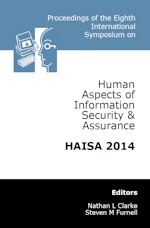In 2014, we launched our open-access repository which offers full text access to conference proceedings from many of our events including the INC and HAISA series. These papers are free to access and distribute (subject to citing the source).
» Openaccess proceedings » Eighth International Symposium on Human Aspects of Information Security & Assurance (HAISA 2014)
 | Eighth International Symposium on Human Aspects of Information Security & Assurance (HAISA 2014) |
Title: Privacy as a Secondary Goal Problem: An Experiment Examining Control
Author(s): Thomas Hughes-Roberts
Reference: pp69-79
Keywords: Privacy, Social Networks, Experiment, HCI, Theory of Planned Behaviour
Abstract: Privacy is a well-documented issue for research with end-users routinely disclosing large amounts of sensitive information about themselves. The privacy paradox, for example, suggests that users are concerned about their online privacy yet behave in opposition to such stated concern. One potential reason for this paradoxical behaviour is that privacy suffers from a secondary goal problem; that is, it is often not considered in conjunction with the primary motivation for using the system. Given that the User Interface (UI) provides the stimulus for interaction this paper proposes that it is ideally placed to remind users of their privacy and motivate them to consider their behaviour with more scrutiny. An experiment is implemented asking participants to sign-up to a social network by answering a series of questions to build their profiles. A treatment is designed based on the Theory of Planned Behaviour which posits that an individual’s behaviour is influenced by their perception of how easy a particular action is to inform; hence, UI elements are designed aimed at aiding users in identifying sensitive information and motivating them to consider their privacy. Specifically, participants are given the opportunity to review their submitted information and make amendments; a privacy score is dynamically altered and sensitive information highlighted to make the goal of privacy protection more salient. Results from the treatment group are compared to a control. Findings suggest that participants within the treatment group disclosed less than those in the control with statistically significant results and there is evidence that user behaviour is influenced by a privacy goal oriented UI.
Download count: 1467
How to get this paper:


PDF copy of this paper is free to download. You may distribute this copy providing you cite this page as the source.
